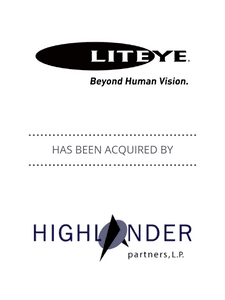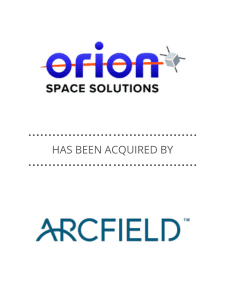Aerospace and Defense
TABLE OF CONTENTS:
- CH. 1: Introduction
- CH. 2: Market Overview & Trends
- CH. 3: Key Players in the Aerospace and Defense Market
- CH. 4: Recent Deal Flow and Multiples
- CH. 5: Factors that Drive Aerospace and Defense Business Owners to Pursue an M&A Transaction
- CH. 6: What Buyers Look for in an Aerospace and Defense Target Business
- CH. 7: What to Consider Before Selling Your Aerospace and Defense Business
- CH. 8: How to Raise Capital for Your Aerospace and Defense Business
- CH: 9: Key Considerations for Growing Your Aerospace and Defense Business Through Acquisition
Chapter 1
Introduction to the Aerospace and Defense Sector
Founders often ask us how the M&A market is trending, whether it’s a good time to sell or recapitalize their business, and what to consider before taking a company to market. This guide is designed to answer those questions specifically for the Aerospace and Defense industry. We will explore the trends that are fueling the industry’s growth and why investors are attracted to this sector. The guide also reviews recent deal activity, the most active strategic and financial acquirers, explains what investors and buyers look for in an aerospace or defense business, what to consider before raising capital or selling your company, and why Forbes is the partner that can help you achieve an optimal outcome.
With many drivers propelling its growth, the aerospace and defense sector continues to attract both strategic and financial investors and acquirers. These investors seek quality target companies that can expand or complement their capabilities, provide access to novel technology, or facilitate entry into new markets.
This growing sector, which encompasses businesses in commercial aerospace, defense, space exploration, and unmanned aerial systems (UAS) is expected to expand at a compound annual growth rate of 2.37% through 2029 according to a recent market report by Mordor Intelligence. These tailwinds are fueled in part by strong US military expenditures, which reached $801 billion in 2023.
This growing sector is expected to expand at a compound annual growth rate of 2.37% through 2029.
Chapter 2
Market Overview & Trends
The aerospace and defense sector includes a broad range of businesses that primarily design, manufacture, and service aircraft, spacecraft, military hardware, and related components. These businesses include both prime and subcontractors, from small startups to Fortune 500 companies like Lockheed Martin, Boeing, and Honeywell.
According to Deloitte, a number of trends will drive healthy growth and expansion in this sector. With commercial and personal air travel rebounding after a pandemic-induced slowdown, demand for aircraft and aftermarket products and services is expected to rise. And with geopolitical conflict and tensions increasing, the US government continues to spend generously on military and defense capabilities. The fiscal 2024 budget for national defense clocked in at $883.7 billion, setting the stage for a strong year for businesses in this sector that serve government customers.
Technology advancements are also driving the sector’s growth. AI is opening the door to new capabilities and solutions, while novel technologies are advancing private space exploration. The development of high-tech unmanned systems (such as drones) and counter-UAS (unmanned aircraft systems) is also on the rise, even amidst legal challenges, regulatory obstacles, and security complexities.
Every new technology brings new entrants to the market or spurs established players to invest in novel approaches to address the industry’s needs. And though a complex regulatory environment proves challenging for startups to navigate, some aerospace and defense subsectors (particular on the software side) require relatively low costs to break into, attracting entrepreneurs with innovative ideas based on emerging technologies. For example, AI has the potential to greatly accelerate new product development in aerospace and defense. And that could allow new entrants to get to market quickly with innovative offerings, including solutions that facilitate smarter, faster decision-making in mission-critical defense situations.
Though the sector is ripe with opportunity, it is not without its challenges. Supply chain disruptions persist at the same time that pressure to buy American-made components is on the rise—causing material and production delays, driving up prices, and requiring companies to find creative sourcing approaches. With skilled talent in short supply at all levels—including engineers, technicians, and production staff—many aerospace and defense businesses find it difficult to stay staffed to meet customer demand. In the face of these challenges, some are investing in digital transformation and the application of generative AI to improve efficiency, enhance productivity, increase throughput, and reduce costs. Meanwhile, the push to reduce carbon emissions weighs heavily financially, requiring manufacturers to make significant investments to meet aggressive sustainability goals.
Other challenges also make it difficult to run a thriving aerospace and defense business. Cybersecurity threats continue to grow in volume and sophistication, and companies in this sector make attractive targets for cybercriminals that seek valuable intellectual property (IP) and trade secrets. Often, government contracts require extensive cybersecurity measures that can be costly for a contractor to implement.
Finally, the threat of technological obsolescence is ever-present for most small and mid-sized aerospace and defense businesses. With entrepreneurs continually developing novel technologies to solve emerging problems or capitalize on lucrative opportunities, a company that stakes its claim on a single product could be wiped out almost overnight by a startup that makes its solution irrelevant.
Per a 2024 outlook by PwC, a number of factors will shape the aerospace and defense M&A landscape this year. This sector continues to consolidate aggressively, with smaller innovators seen as ripe for acquisition by mature companies seeking to add capabilities or talent quickly. At the same time, the rate of consolidation has sparked antitrust concerns, despite the US government’s interest in funding aerospace and defense innovation. And the current interest rate environment has caused some buyers to rethink pursuing large acquisitions that require some degree of debt financing.
Instead, industry sources believe the big strategic acquirers will set their sights on acquiring smaller businesses in this fragmented market, especially in specialized areas like hypersonic, space, and unmanned systems. With a good deal of capital left to deploy, private equity (PE) groups are likely to compete for similar target companies as lucrative add-ons to their platforms. In fact, amidst greater scrutiny of aerospace and defense deals over antitrust concerns, PE groups might focus on combining several small or mid-sized target companies to create a synergistic business with the innovation and resources to grow aggressively.
In this complex yet high-potential environment, smaller aerospace and defense businesses that offer technological advantages, solid cash flow, human talent, strong revenue potential, and long-term contracts are finding they can attract the attention of strategic and financial buyers.
Ready to Discuss Selling Your Aerospace and Defense Business?
Chapter 3
Key Players in the Aerospace and Defense Market
Strong growth prospects for this sector continue to prove a draw for both strategic and financial acquirers, each with their own objectives.
Strategic buyers typically view an aerospace or defense acquisition as an effective way to add new capabilities, expand their market or geographic reach, or complement their product or service offering. Major players like Lockheed Martin, Raytheon, and Boeing regularly complete high-profile transactions in this sector. Other prime contractors that aren’t quite as large often pursue small or mid-sized subcontractors with innovative capabilities that provide a competitive advantage. This trend is especially evident in emerging, high-potential subsectors like unmanned systems, hypersonics, space exploration, and cyber defense.
Some of the most active strategic acquirers in the aerospace and defense sector include the following:
-
- BAE Systems, which agreed to acquire Ball Aerospace, a major supplier of space systems and defense technologies with applications that span air, land, and sea
- Viasat, which acquired Inmarsat, a provider of global, mobile satellite communications
- L3Harris, which acquired Aerojet Rocketdyne, a provider of propulsion systems and energetics to government agencies
- General Atomics, which acquired EO Vista, a provider of advanced space-based and airborne electro-optical payloads
- Saab, which purchased BlueBear Systems, a provider of AI-enabled autonomous swarm systems and command-and-control systems
PE groups and other financial buyers are also attracted to this sector and primed to lend their capital, industry knowledge, and operational expertise to A+ aerospace and defense companies.
While The Carlyle Group, KKR, and Blackstone are all very familiar names among aerospace and defense financial buyers, the following deals involved other highly active financial buyers in this sector:
-
- Arcline Investment Management acquired Hartzell Technology, which designs and manufactures proprietary aircraft subsystems and aftermarket components
- Chargers Investment Partners acquired Unitech Composites, a composites supplier that focuses on the fixed wing and rotary aircraft segment of the defense sector
- Veritas Capital Management acquired Chromalloy Gas Turbines, an aircraft parts manufacturer
- Highlander Partners acquired Black Sage, a platform provider of counter unmanned aircraft systems
Ready to Talk to an Expert?
Chapter 4
Recent Deal Flow and Multiples
The deal flow within the aerospace and defense sector has been relatively robust in recent years, particularly for companies that specialize in high-growth areas like cybersecurity, space technology, and unmanned systems. According to a PwC report, over the past two years M&A deal volume in this sector peaked in Q4 2022, with 107 transactions recorded, then hit a trough in Q4 2023, with only 49 deals closed. However, by early 2024 that trend had begun to reverse as the deal pipeline seems to be filling up.
Middle market transaction multiples in the aerospace and defense sector can vary widely depending on the subsector, the size of the companies involved, their market position, their financial performance, and the specific dynamics at play at the time of the transaction. It’s important to note that broader economic conditions, interest rates, and sector-specific trends also influence transaction multiples.
Here’s a general guide to transaction multiples within various aerospace and defense subsectors, keeping in mind that these are approximate ranges and can fluctuate.
Commercial Aerospace
- OEMs (original equipment manufacturers): EV/EBITDA (enterprise value/earnings before interest, taxes, depreciation, and amortization) multiples typically range from 8x to 12x.
- Suppliers: Multiples can vary significantly, from 6x to 10x, depending on the tier level of the supplier and the criticality of the components they provide.
Defense
- Prime Contractors: These entities often see multiples from 10x to 14x, reflecting their stable revenue streams from government contracts.
- Tier 1 & Tier 2 Suppliers: These suppliers, which provide key components and systems, usually have multiples in the range of 8x to 12x.
Space
- Satellite Manufacturing: Multiples in this innovative subsector can be quite variable, ranging from 8x to over 15x, depending heavily on their growth prospects and technological advancements.
- Launch Services: With the commercialization of space, these services can see multiples from 10x to potentially over 20x for those with unique capabilities or market positions.
Unmanned Systems and Drones
- Manufacturing: These are typically on the higher end due to the growth potential, with EV/EBITDA multiples ranging from 8x to 15x, especially for companies with differentiated technologies or strong market footholds.
- Services: These are typically not as high, with EV/EBITDA multiples ranging from 4x to 6x.
Cybersecurity & Defense Electronics
- Given the critical importance of cybersecurity and advanced electronics in modern defense systems, companies in this space can command multiples from 10x to 15x, with particularly innovative or market-leading firms possibly exceeding these ranges.
MRO (Maintenance, Repair, and Overhaul)
- Multiples for MRO companies can range from 6x to 9x, reflecting the more cyclical and competitive nature of this subsector.
These ranges are broad estimates and should be used as a starting point for more detailed analysis. Specific transactions can fall outside these ranges based on unique value drivers or market conditions at the time of the deal.
Chapter 5
Factors that Drive Aerospace and Defense Business Owners to Pursue an M&A Transaction
Despite macroeconomic and geopolitical uncertainty, current market conditions could prove favorable for selling a high-quality aerospace or defense business. Continued consolidation—coupled with technological advancements, strong defense spending, and the strategic nature of certain subsectors—combine to create a positive environment for selling an A+ business in this sector.
The decision to the sell the business you’ve worked hard to build is never an easy one, and typically there is no single factor that tips the scales. However, the following tend to weigh into the decision to sell.
Awareness that it’s time for new leadership.
- While it can be difficult to admit, the most self-aware business owners recognize when the company has hit a plateau and requires new leadership with different skillsets and resources to drive the business forward.
Interest in starting a new venture.
- Some business owners are lured by the novelty of starting another company. An acquisition can provide the capital to start up a new business in the same or different subsector.
Financial goals.
- Savvy entrepreneurs in this sector often leverage favorable market conditions and a strong market position to take on a minority or majority investor now, roll over some equity, and get a second windfall when the investor sells the company later.
Retirement goals.
- Whether they’re driven by burnout, health issues, or an interest in pursuing personal endeavors, business owners in this sector might find the lure of retirement beckoning.
Operational challenges.
- Keeping your product or service offering current and avoiding technological obsolescence is especially difficult in the dynamic A&D sector. It’s also difficult to keep fully staffed with top talent, maintain regulatory compliance, and secure your IP rights. Amidst these challenges, you might decide it’s time to turn the reins over to someone else.
Derisking and liquidity goals.
- Many aerospace and defense business owners find that a disproportionate share of their total net worth is tied up in their equity in the company. Some founders see a sale or a majority investor as a good means to gain liquidity, diversify, and reduce risk.
Chapter 6
What Buyers Look for in an Aerospace and Defense Target Business
Whether it’s a strategic acquirer or PE group, an investor that sets its sights on the aerospace and defense sector will bring certain expectations when it comes to evaluating a target company. The following characteristics tend to top the list for most investors in this sector.
Technological innovation.
- With technology advancing faster than ever, buyers seek businesses that continually innovate to stay one step ahead of the competition. Conversely, they avoid companies that have all their eggs in one product or service basket, since that raises the risk of technological obsolescence. Savvy buyers understand that it only takes one superior competitive product to wipe out the entire revenue of a company whose fortunes hinge on a single product.
Market position.
- Both strategic and financial acquirers gravitate toward businesses with an exceptionally strong market leadership position.
Strong talent.
- In a persistently tight labor market, a lack of skilled talent can make or break any business. Highly specialized talent, like engineering, is especially difficult to secure and retain.
Long-term sustainable revenue.
- To reduce their risk, buyers look for a clear line of sight to strong future revenues. This is because you are selling your business’s future, not its past. The more data you can provide to demonstrate your revenue growth is sustainable, the higher the multiple and the better the deal. For example, both long-term contracts and a high contract renewal rates both provide higher confidence in future revenues and result in higher multiples.
Strategic buyers also look for deals that enable them to gain capabilities or technologies that complement their own, setting a foundation to address new customer segments or expand into new markets. Financial buyers seek target companies that are poised to continue on a strong growth trajectory, maintain good profitability, and generate strong returns. PE groups and other financial buyers typically expect the target business to grow rapidly, so they can exit in a relatively short timeframe.
Chapter 7
What to Consider Before Selling Your Aerospace or Defense Business
Before you embark on selling your company, you’ll need confidence that it’s the opportune time to sell and that your business is in the best position to achieve the optimal deal price and terms. To assess whether you are ready to take this major step and whether your company would be considered a quality target, ask yourself the following questions.
Are your financials investor-ready?
Buyers expect to review financial statements that are accurate, current, and well-documented. Be sure your income statement, balance sheet, and other financials can stand up to an investor’s scrutiny.
Is your customer base diversified?
This question is closely tied to your revenue quality and risk. Smaller aerospace and defense companies that derive a significant portion of their revenue from a single customer (such as the US Department of Defense or the US Navy) will have more trouble securing a good deal than businesses with a larger, more diverse customer list.
Are your contracts long-term?
As explained earlier, buyers prefer aerospace and defense companies that lock up their customers through profitable long-term contracts and the ability to renew those contracts at a very high rate. In fact, high customer concentration has been known to kill deals. Newer entrants that haven’t been through a renewal cycle might find this criterion to be an obstacle.
Have you protected your IP?
Since a review of legal issues is always part of the due diligence process, be sure you have secured your IP properly against legal challenges through measures like trademark and patent protections.
Are you running a tight ship?
While many buyers seek companies that offer improvement opportunities which can translate to a high ROI, they also prefer target businesses that have already taken steps to streamline operations and improve efficiency.
Have you secured key talent?
Savvy buyers know that many middle market businesses are highly dependent on a handful of key employees. To avoid keyman risk thwarting your deal, secure your key staff with employment agreements and financial incentives that create the talent continuity an investor expects.
Are you continually innovating?
Technology is a critical underpinning for many businesses in the aerospace and defense sector. The more you can demonstrate you are staying on the cutting edge, the more appealing your business will be.
Do you have a compelling profit and growth story?
While all the above are critical to securing a lucrative deal, the bottom line is that buyers seek businesses that can demonstrate a healthy growth rate and strong EBITDA (earnings before interest, taxes, depreciation, and amortization) margins.
Ready to Discuss Selling Your Aerospace and Defense Business?
Chapter 8
How to Raise Capital for Your Aerospace and Defense Business
If you decide it’s not the ideal time to sell your business, you might find you can achieve important near-term goals by raising capital. With sufficient capital at your disposal, you can fund faster growth, invest in new innovations that keep your company ahead of the curve and technologically relevant, recap out previous or early stage investors, or gain liquidity to diversify your net worth.
There are two primary forms of capital: debt and equity. Deciding which is best for you starts with understanding how each option works, along with their advantages and disadvantages.
Debt capital typically involves bank loans or corporate bonds, but sometimes includes mezzanine financing. Business owners in the aerospace and defense sector might use debt capital for short-term or limited capital needs, such as increasing working capital or investing in novel technologies. In most cases debt capital is relatively fast and straightforward to obtain and readily accessible to financially healthy companies, and it can offer tax advantages. Taking on debt, as opposed to giving up equity, also allows you to retain greater control of your company. However, at times of high interest rates it can prove a costly approach. To qualify for debt capital, you’ll need to demonstrate that your current and projected cash flows can service the debt and you can satisfy the lender’s collateral and credit rating requirements.
Equity capital is obtained by providing an investor with minority ownership of the business in exchange for capital. It can help an aerospace or defense company fund large, long-term initiatives (including an acquisition) or significant ongoing needs. But taking on a minority investor means diluting your ownership and turning over some degree of control, especially over major decisions. On the other hand, diluting ownership also spreads your risk, which some business owners might find advantageous.
Which form of capital is right for your aerospace or defense company? There is no single right answer. The best form of capital for your business will depend on factors like how much debt you’ve already taken on, the cost of capital (which can be high on a debt deal at times of high interest rates), the current market conditions, and your intended use for the funds. Your lifecycle stage might also impact your decision to choose debt vs equity capital. Innovators in the pre-revenue stage are likely to find it difficult to obtain debt capital, while more mature businesses with a track record of revenue and profitability growth will likely find they can choose from either debt or equity capital.
With various options to choose from and many factors to consider, raising capital can be a complex undertaking. Owners of aerospace and defense businesses often find it valuable to hire an investment banker that can guide them through the complexities and help determine the optimal capital structure. An experienced investment banking partner will ask about your objectives and your intended use for the funds, then recommend the right capital structure, market your business to appropriate capital sources, and negotiate and finalize the terms.
The Forbes Guide to Middle Market Capital Formation is an informative and comprehensive resource for aerospace and defense business owners that are looking to raise capital.
Chapter 9
Key Considerations for Growing Your Aerospace or Defense Business Through Acquisition
Regardless of market conditions, you might decide to postpone selling your business because you feel the company isn’t in prime position for an optimal deal just yet or you are not ready to move on to other pursuits. If your business still has plenty of opportunity to build value, you might seek to acquire a company in order to grow further and faster than you could organically.
Though acquiring another company is hard work, the rewards can be substantial, creating a 1+1=3 proposition in which the whole is greater than the sum of the parts. The right target company could strengthen your business by broadening your product or service offering, positioning you to serve a new customer segment or geographic market, or attracting the talent to pursue and fulfill new contracts.
If you decide an acquisition strategy has value, you’ll need to evaluate potential target companies diligently. The criteria you use will be very similar to what a strategic acquirer or PE group would look for if they were evaluating your business as an acquisition target. At a minimum, consider factors like the following:
-
- Financials. Assess the target company’s financial health and performance by reviewing their financial statements and projections in depth. Pay close attention to their revenue trend and sustainability, along with their profitability and current debt load.
- Strategic fit. When a middle market aerospace or defense company decides it’s time to make an acquisition, they’re usually in search of a business that can complement theirs in a way that will facilitate growth. For example, you might seek to buy a business that brings a novel technology or other capability you can’t build up quickly or a company with a presence in key markets that are on your radar.
- Customer base. Companies with a high concentration of revenue in one or two large customers present risk, so look for businesses with a diverse customer base. Ideally their customer base will complement yours, rather than duplicate it.
- Technology. Often, a good-fit target company in this sector is one that offers access to new technological capabilities compatible with your current technology foundation. That means they can add value and help you protect against technological obsolescence, without creating undue integration challenges.
- Cultural fit. Just as important as technological fit, cultural fit is a key consideration in any acquisition. A culturally compatible business will be easier to integrate operationally and will improve the odds of long-term success.
- Talent base. Given the tight labor market and the particular challenges of attracting the highly skilled talent this sector requires, a business with a strong talent base could eliminate or ease a key growth constraint.
How Forbes Partners Can Help
Though market and geopolitical volatility remain in focus, many other factors make this a good time for A+ aerospace and defense businesses to consider selling. For owners of exceptional companies in this sector, Forbes Partners is the right advisor to guide you to a successful deal outcome.
Forbes Partners is highly experienced in navigating a dynamic M&A market, brings a strong track record of guiding middle market companies through minority investment or a full sale, and understands the unique challenges and opportunities facing owners of aerospace and defense businesses. We also have strong relationships with a large network of strategic and financial acquirers, so we know what they look for and how to position an aerospace or defense business to appeal to them.
Forbes Partners’ most recent aerospace and defense sector transactions include these successful deals:
- Serving as the advisor to Liteye Systems, a leader in Counter-UAS technology and solutions, in its acquisition by Highlander Partners
- Representing Orion Space Solutions, a provider of end-to-end space mission capabilities and solutions, in its sale to Arcfield
Complementing our sector-specific experience, the Forbes Partners team is highly skilled in crafting a compelling story about your aerospace or defense business and creating a unique and defendable position that can help you achieve an optimal outcome. If you are not quite ready to sell, our advisory services can help you build greater value now and place your business in a stronger position for an eventual sale.
Talk with Forbes.
Exceptional businesses in the aerospace and defense sector need an exceptional investment bank. Forbes Partners has the necessary expertise and will focus its efforts toward achieving optimal outcomes for you.
Forbes Partners is an award-winning middle market investment banking firm focused on driving maximum value to clients. We help our clients restructure debt or recapitalize their business to meet evolving needs. Many owners desire liquidity while still maintaining control of their businesses. Forbes Partners can help them achieve their goal. Our experienced bankers think strategically about value creation — we are market makers, and our clients expect nothing less.












